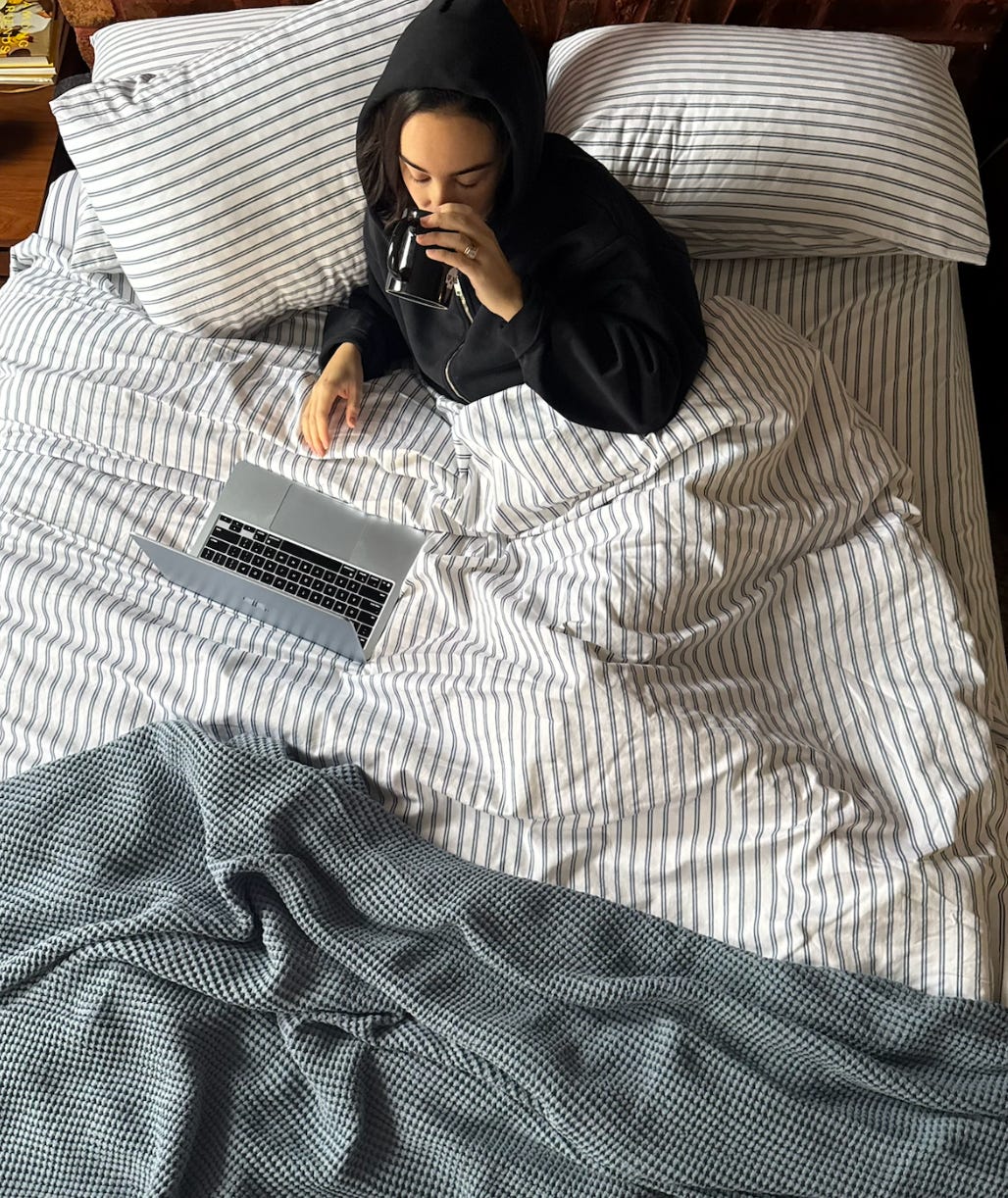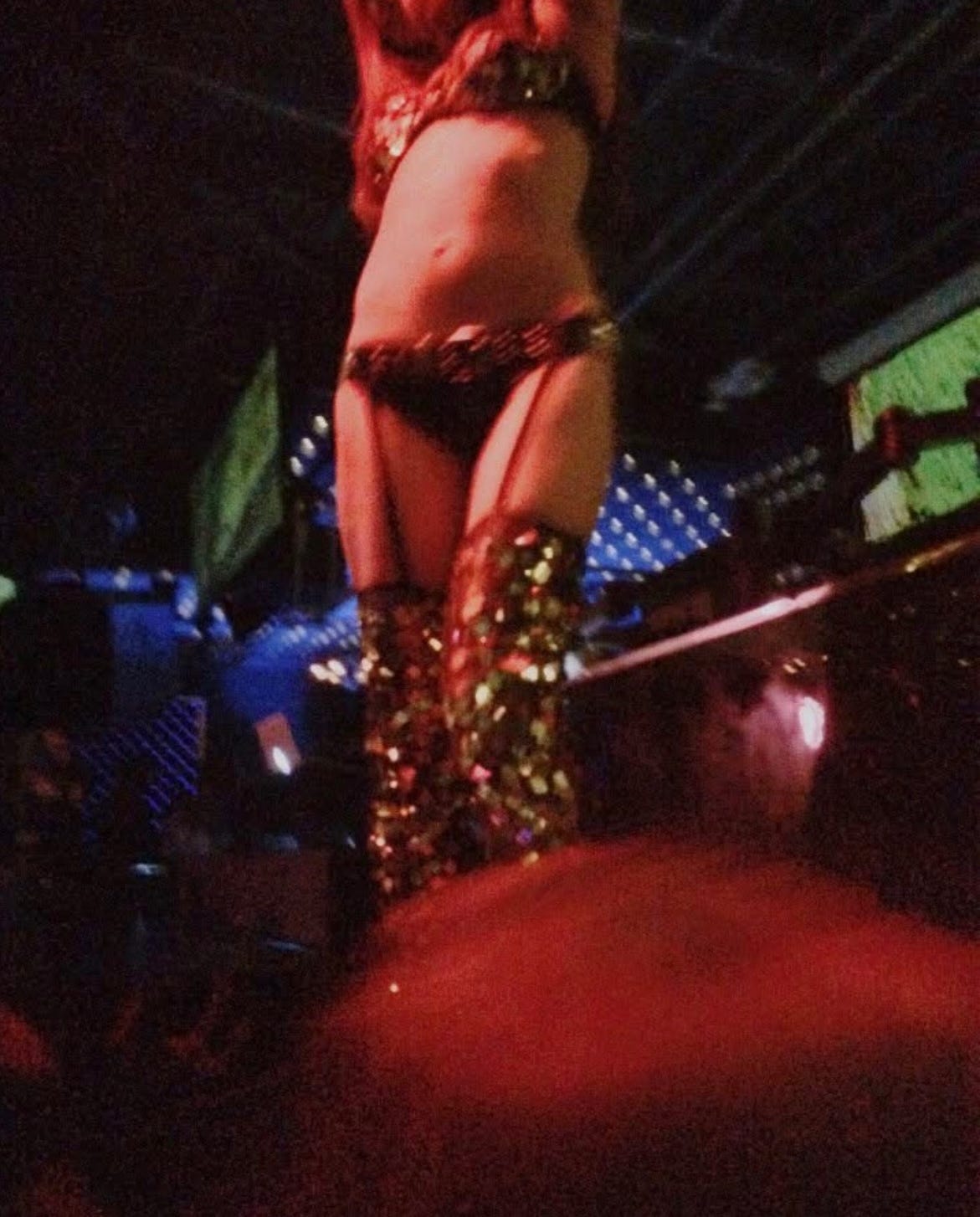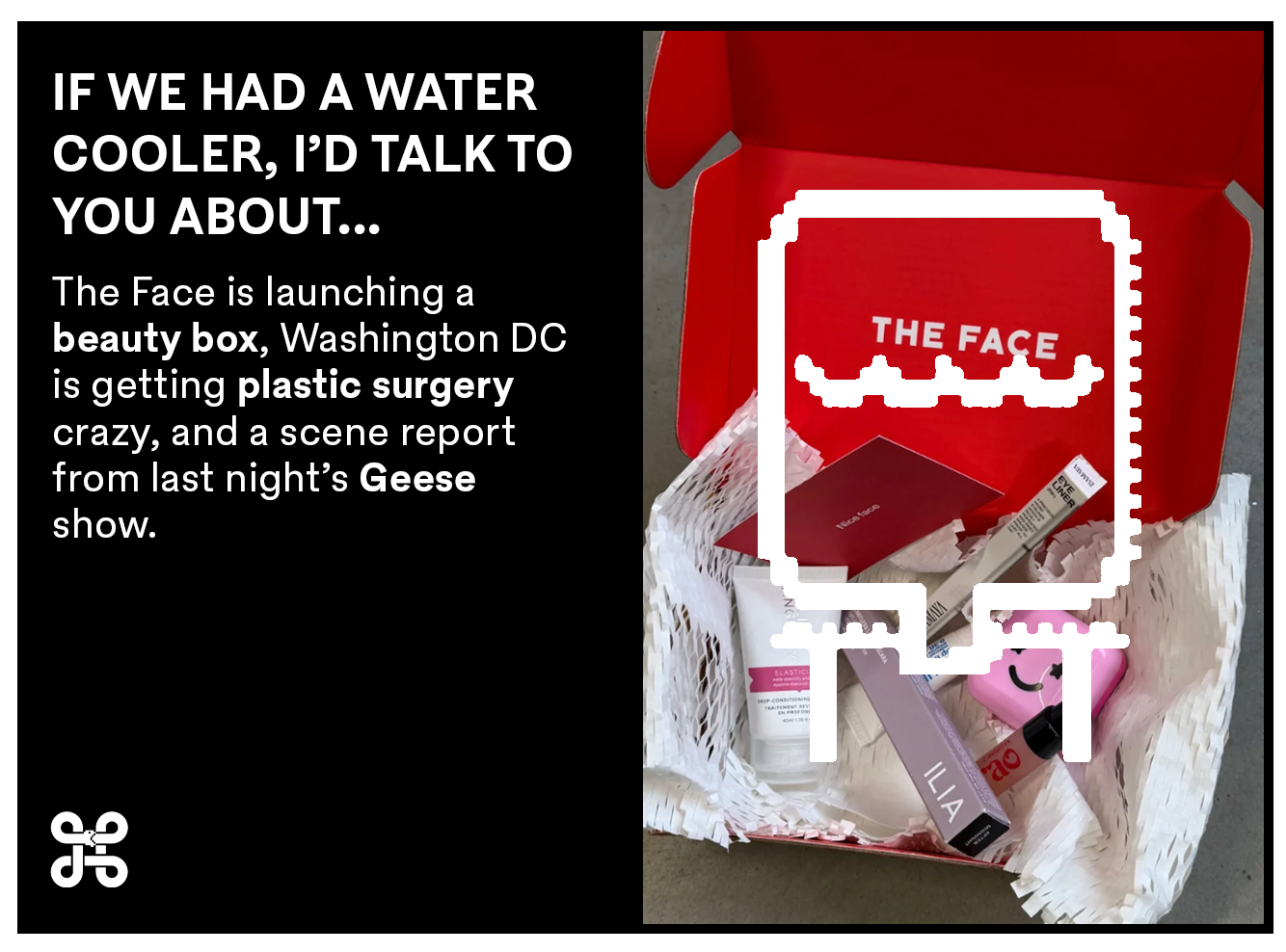How New York's wildest teens of the 2010s partied.
Andrew Zucker on Hervé Léger, 1Oak, and private school club rats.
Today’s letter is free to all readers because it’s sponsored by Brooklinen.
Hello everyone. I’m sorry to the woman who asked me for a Feed Me keychain outside of Cherry Lane Theater last night. If you shoot me an email, I’ll send you one when I restock. I had dinner at Wild Cherry last night, where I saw four people I knew and was delighted by their dice-sized cubes of brownie served alongside a soft serve sundae.
In today’s letter:
on 2010s club culture, The Face is launching a beauty box, Evercore’s employee gift guide, and the latest crime in DC is Mar-a-Lago-inspired filler.This week, the Feed Me Job Board has open roles at ShopMy, Fora, and Brigade.
I’ve been to five states since September: Arkansas, Tennessee, Connecticut, Louisiana, California. I slept in beds that were bigger than mine, on streets quieter than mine, with blackout curtains I keep telling myself I’ll buy. But nothing feels better than coming home to my bed, made (imperfectly) with Brooklinen striped sheets. On cold mornings, the Dreamweave Waffle Blanket usually comes with me to my desk. If you travel as much as I do, you know that leaving home is almost always worth it, but the best part of the trip is coming back to your own bed. Brooklinen’s Black Friday Sale — for 25% off sitewide, and up to 40% off bundles — starts now. It’s their biggest sale of the year.
Social Skills is a monthlong Feed Me series to help you survive the most social season of the year. Today, writer and Town & Country contributing editor Andrew Zucker on the private school club rats of the 2010s.
Some claim that New York City private school kids grow up “too fast.” Based on what I saw in my time as a student at the Upper West Side’s Columbia Grammar and Preparatory School in the early 2010s, that may be the world’s greatest understatement. While my Saturday nights in high school were marked by binging Shark Tank and ordering in chicken fingers and fries from Jackson Hole, my classmates were basically the teenaged version of the Pussy Posse. (They knew I was busy).
Back then, rich fifteen-year-old New Yorkers didn’t hang out behind malls in bean bag-filled suburban basements: they went clubbing. Wearing Hervé Léger bandage dresses and shiny Moncler puffer jackets, they armed themselves with fake IDs and spent school nights popping bottles alongside Justin Bieber, Leonardo DiCaprio and Tobey Maguire. For many of these high schoolers, mom and dad were the names of ATMs rather than moral authorities, and they took advantage of the ZIRP-like feature to buy bottle service.
Today, those late nights at Stash, Riff Raff’s, Up&Down, 1 Oak, and Finale feel like a bygone era of Manhattan nightlife — perhaps even a golden age. I decided to call up New York’s young private school club rats of the 2010s to see what I missed out on, and find out how baby-faced fourteen-year-olds made it inside the Big Apple’s buzziest nightclubs. Given the fact that every one of them broke the law for being underage, their names have been anonymized.
ALEX: One of my first times going out was at Lavo. I think I was maybe 15. I go to the bouncer, I’m wearing a fucking jacket and a shirt — when you’re 15 wearing a blazer and a shirt, you look like a kid wearing a blazer and a shirt — and give him my ID. He gives it back to me and goes, “The Toys R Us is down the street.” I think I ultimately got in because my brother was there, but you had to jump through hurdles.
CALEB: The first time I ever went to a nightclub I was 13 or 14, and a bunch of the older kids in school asked me if I wanted to go out. I didn’t know how much these things cost. I had the best night of my life, and the bill came at the end and I look and everyone had left. I’m thinking, ‘Maybe these guys paid before.’ The waitress comes over and goes, ‘Are you paying cash or card?’ And I go, ‘For what?’ The bill was two and a half thousand dollars. I had a debit card with all of my Bar Mitzvah money. Long story short, I paid for it.
GABE: You’d usually go to the place where someone knew someone, and that often included a nice thank you gift to the bouncer.
“You have college girls who are from God-knows-fucking-where, Florida. It’s pretty interesting being 15 years old talking to a 21-year-old girl in college in New York.”
ERICA: If you were with guys getting the table, either you could show a bad fake ID or they would just wave you in because those guys got tables so often and they were giving them so much money continuously.
NICK: Everyone went to Riff Raff’s. Stash was the first one I went to.
CALEB: Riff Raff’s was tougher to get into. But to get a picture of you with a painted face? The girls went crazy for that.
For many students, clubbing was as regular a weekend activity as AAU basketball games. In unique circumstances, it became a school night activity. That meant clubs regularly sold tables to underage patrons. Did the clubs know?
GABE: At the end of the day, these nightclubs are businesses. So if your money’s green and you’re paying, there’s been a lot of crazier stuff that’s happened there then letting underage kids in.
SAMANTHA: The guys were basically going every weekend at that point and had access to their parents’ credit cards. So they’d buy $3,000 tables every weekend. Bottles, sparklers, the whole thing. And so that’s how they became very known in the clubbing scene.
NOAH: At the cheaper spots, a one bottle minimum was maybe 800 bucks, which you’d split with a few people. But at 1Oak or Up&Down, they were like $3,500, $4,000, something like that.
GABE: Most guys would throw in $500 each. You’re bright-eyed and young and it’s all pretty new at that age. You’re never having a bad night out, you’re just happy to be there. However old you are — ninth grade — feeling like you’re hot shit, popping a bottle of champagne. It’s just fun at that age.
CALEB: A lot of the time, if there was a performer, cops would often try to raid the nightclub and check peoples’ IDs and stuff. But the nightclubs would get a heads up and they would sneak the people who they assumed were underage through the back door into a secret room. They had all this down pat. This was, like, part of their protocol.
ERICA: We definitely left in a hurry sometimes.
MICAIAH: You have college girls who are from God-knows-fucking-where, Florida. It’s pretty interesting being 15 talking to a 21-year-old girl in college in New York. I think one of the first times I kissed a girl was in a place like Stash. She was six years older than me.
And what about their parents? Were they unwittingly (or wittingly) funding 15-year-olds’ clubbing habits?
ERICA: My dad came to my eighteenth birthday at Finale, brought me and my friends in. I guess he thought it was normal. I asked my dad, thinking, ‘If he doesn’t let me do this, that is so fucked up.’
ALEX: It really depended on the parent. Some of them were loosey goosey. Some of them were a little bit more uptight.
ERICA: There was a group of guys that called themselves ‘Team Type It In.’ It was basically where you would have a picture of your parents’ credit card or you memorized your parents’ credit card. You would ask the club at the end of the night after you got a table, ‘Can I type it in instead of swiping a card?’ And that’s how they would pay for tables without paying for themselves or having to get money from their parents. Either their parents would notice the next day and they would get screamed at and get in trouble, or their parents would never notice and they would keep doing it.
CALEB: A friend of mine told us, ‘Hey, it’s New Year’s Eve. If you want to come out with us, it’s going to be $700 each.’ My buddy who didn’t have the same level of money was saving up for weeks and weeks, collecting money from his grandma, his brother, $100 here, $100 there. He finally got the $700 to go out and he had it in tens and twenties and ones and fives. He got to the nightclub and the kid asked for the money and instead of collecting it, he took the stack of bills and threw it up into the air. Everyone was trying to collect a few dollars and the kid, who was my good friend, the life went out of his eyes.
Some club rats encountered people they weren’t supposed to see. And some people experienced dangerous situations.
CALEB: One night at Lavo when I was 16 or 17, I was waiting in line and I heard a familiar voice behind me. It was my teacher at the time. We ended up inviting her in and we went to a nightclub together. We made a pact to not talk about it. We paid for her drinks.
ERICA: I once ran into one of my dad’s friends at 1Oak, and he told my dad. I was grounded for like a month.
SAMANTHA: One of the nights we were told we’re gonna go to another club, so we get in a car with these guys. We were probably 16, and they were in their 40s. And they have their driver and we’re pretty drunk. Then suddenly we’re like, ‘We’ve been driving for a long time,’ and look out and we’re getting on a highway. It was completely sobering. You’re just like, ‘This isn’t fun anymore. I want to go home.’ They tried to kind of convince us otherwise, because I guess we were going to Long Island to one of their houses. Eventually I sobered up and convinced them to drop us at a gas station. You look back and you’re like: we could have just been trafficked right there.
ERICA: Looking at pictures is actually sickening. It definitely could have gone really south. Clearly, my frontal lobe was not developed at the time, so I didn’t know what was a dangerous situation. There was definitely a cast of characters. We would go out and meet people that were in their 30s and think it was funny.
Today, many of those clubs have shut down. Others have raised money, become more popular, and expanded globally. Yet one thing’s for certain: the swashbuckling days of bopping between nightclubs in New York as a teenager are over.
CALEB: From the real glory years of New York City nightlife, these places made so much money that they were able to branch off and get private equity investments. It’s all different now. They’re not going to risk their local license or their brand for some kids. It’s gotten a lot more difficult for kids to have those ridiculous experiences. There’s less nightclubs and there’s more members clubs now, which are harder to get into.
NOAH: I think there’s a lot of weird life lessons in dealing with people and doing that at such a young age.
SAMANTHA: I have no interest in raising my kids in New York City. Because it may not be clubs, but it’s going to be some form of that in a different way. I knew what I got into and I think I got pretty lucky to get out of it. But a lot of people I know didn’t have that same luck and are still very in that scene and haven’t done a lot with themselves in their life.
“I had a career in tech and now I’m a full time mom to a toddler. Your newsletter keeps me feeling connected to the ever changing worlds of business and culture so I’m still fun at parties.” - Cissy, paid reader
The latest deal with the devil being made in Washington, DC: excess filler. Axios reported that plastic surgeons in DC are seeing an uptick in requests for something being called “Mar-a-Lago Face.” This is not the aesthetic revolution the city needed. I texted Friend of the Letter, DC-based writer
, to see if this new look was legit: “I’d say that the day-to-day people I see don’t have it as much, but you see it a lot more when they congregate, when richer Republicans come to town, when there’s a big event. Staffer aesthetics are still very Tuckernuck, J. Crew, big hair. But it’s very visible around town when, like, CPAC happens.” Another friend who would like to be referred to as ‘Undercover Republican’ told me, “The MAGA ladies are looksmaxxing. From the people I interact with mostly — White House and Hill staff — you see less of this. The big blowouts are the main indicator of the MAGA look, followed by the poofy dress and heavy makeup, but that’s because the staff is mainly young and underpaid. I see more of that Mar-a-Lago plastic surgery look with the mistresses, influencers, reporters.”Niche news: Vox redesigned their job site.
The CEO of a private college admissions counseling firm wrote about the rise of the “Vibe School.” She says that now, more than ever, her affluent clients are choosing to apply to schools based on “vibe.” These schools tend to be “socially vibrant,” “strong in pre-professional fields, especially business,” located in “lifestyle destinations,” and “popular among students from affluent zip codes and top private high schools.” Crucially: the “vibe schools” are not making headlines for “political protests and leadership turmoil.” Tuition fees aren’t mentioned once in the article, and this college counselor’s own fees aren’t listed on her website, but you can make assumptions, given that she offers pre-college counseling to children in grades 4-8.
Happy birthday, Tina Brown! I met
for the first time earlier this year in London. If you haven’t read her recent interview in The New York Times, you should: “I am so bored, frankly, with the über-rich thinking that just because they’re rich, they know everything about everything.”In an extremely 2018 move, The Face launched a beauty box. Doesn’t look bad.
The best gift guide isn’t on Substack. It isn’t in the pages of a glossy magazine, or on an Instagram carousel. It’s in the inbox of Evercore employees. Last year, a reader tipped me off that the investment bank sends out an annual gift guide to staff with suggestions for what they should buy the people in their lives. The guide has five price tiers, from $ (under $100) to $ ($1k+). Suggestions include a Khaite Belt “tbh anything from Khaite would also be a big hit,” and Salomon Sneakers “the cool girl sneakers in NYC right now even though these are engineered for hiking lol.” Last year, the subject line read, “Holiday gift ideas for women (mostly) ... Guys, hope this helps :)” This year it was more gender neutral, titled simply, “Holiday Shopping Ideas.”
Half my timeline was at the Geese show at Brooklyn Paramount last night.
According to a Friend of The Letter who attended the show, there was a small crowd of people outside the venue begging for tickets, which had gone on sale months ago for $48 and were now listed for nearly $400 on resale. His review:
“There was a much bigger generational spread than the average New York rock show, though, and a lot more women – although everyone was extremely horny for lead singer Cameron Winter regardless of gender. A cross-selection of people who looked like they’d been plucked from 169 Bar, Rolo’s or Coyote Club sang along and moshed to every song. If seeing The Dare feels like a weak cosplay of an LCD Soundsystem show, watching Geese rock out felt closer to what it might have been like to see The Strokes at the height of indie sleaze. ‘This song’s about a lot of fucking horses!’ Winter shouted at one point, prompting screams and a dude in a horse mask to crowd-surf through the pit.”









Today’s letter made me miss Gold Bar and promoters and Uproar by Lil Wayne
There truly will never be anything like the old-school clubs of NYC. Just, nothing.
Also, I hope that you and Tina Brown somehow end up doing something, Or at least TB does a Guest Lecture.